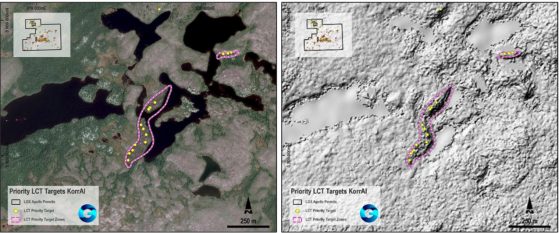Artificial intelligence will play a key role in the exploration strategy of Lithium Universe Ltd (ASX:LU7) with the company to work closely with KorrAI Technologies Limited in Canada to enhance field exploration practices, optimise time spent and cost in the field at its Apollo Lithium Project.
Apollo commands a land position spanning more than 240 square kilometres and is in the same greenstone belt and only 29 kilometres southeast of the Corvette Lithium Project owned by Patriot Battery Metals (market cap of over A$1.4 billion).
LU7 aims to become a prominent lithium project builder by prioritising swift and successful development of lithium projects. Its mission is to quickly obtain a resource and construct a spodumene-producing mine in Québec, Canada, and it possesses the expertise and skill to develop and construct profitable projects.
The company has access to significant lithium opportunities in Tier 1 mining jurisdictions in Canada and Australia.
Use of AI expected to fast-track aims
"We are pleased to announce the exploration strategy developed for the Apollo Lithium Project, which includes the innovative use of Artificial Intelligence (AI) in collaboration with KorrAI Technologies,” LU7 chairman Iggy Tan said.
“KorrAI has been successful at utilising satellite data and AI technology to optimise field exploration practices in the James Bay area. They have worked for companies such as Patriot Battery Metals nearby.”
KorrAI will employ advanced algorithms to create maps that identify geological features like outcrops, pegmatites and vein formations, using spectral data to locate potential mineral deposits.
“This AI-driven approach enhances exploration accuracy and efficiency, allowing us to focus our field activities and resources more effectively, reducing exploration timelines and costs,” Tan said.
How KorrAI uses artificial intelligence
KorrAI’s key approach involves using Artificial Intelligence to process and analyse satellite data and images. Spectral data also helps identify areas that are more likely to have valuable mineral deposits.
The data will help LU7’s field teams to focus on specific locations with high potential.
Leveraging AI technology, LU7 has enhanced the precision and effectiveness of its exploration initiatives, allowing its field teams to better direct their activities and distribute resources.
This strategic approach helps cut down both time and costs associated with exploration — a vital move, especially given the region's condensed exploration period due to winter conditions.
In recent efforts, a comprehensive study was carried out on the Apollo property to unearth lithium-caesium-tantalum (LCT) minerals using a blend of advanced technologies. This includes remote sensing, airborne and ground-based geophysics, coupled with artificial intelligence.
The research gathered diverse data sets from satellites and airplanes, integrating information from visible and infrared light, microwave signals, and magnetic readings. This diverse dataset painted a holistic image of the property. Subsequently, AI models were utilised to process the data, pinpointing potential zones rich in valuable minerals.
From the AI's findings, 448 priority zones were identified within Apollo. This list was further distilled to 28 prime locations, which are now slated for field mapping and sampling.
Left image normal satellite data covered with glacial sediments; right image using AI technology to identify whaleback patterns in topography and target areas.
Left image normal satellite data covered with vegetation; right image using AI technology to identify whaleback patterns in topography and target areas.
Validating satellite-derived targets through geological mapping, collecting field samples and contextual photography is essential to the Apollo Project.
Ground-truthing plays a vital role in correlating geological features, enriching knowledge and minimising the risk of inaccurate results or 'false positives'.
To further solidify data accuracy, field samples and supplementary datasets, like high-resolution magnetics and hyperspectral data, are utilised. This meticulous approach provides a solid foundation for refining AI modelling methods, ensuring they're more effective in guiding future sampling and determining drill targets.
The methodologies adopted for the Apollo Project are comprehensive, drawing from a vast range of datasets. These include visible, near-infrared, shortwave infrared, microwave (radar) and magnetic data sourced from a combination of satellite and airborne platforms.
Notably, the predictive AI models employed have a history of reliability - they've been trained and field-tested in various locations throughout the James Bay region. The focus of these models has been on targeting LCT pegmatites, with convolutional neural networks being instrumental in digitizing anticipated features.
Three-phase exploration strategy
LU7 is using AI technology in conjunction with staged ground-truthing activities and airborne and ground-based geophysics techniques to further develop its overall Apollo exploration strategy, in addition to future work streams designed to improve orebody knowledge and future resource development. The three-phase strategy consists of:
Phase 1
Regional prospecting and mapping to decipher geological context and identification of host rocks for LCT pegmatites including:
- High-resolution airborne magnetic survey at 50-metre line spacing;
- Ground-based gravity survey at 25-metre and 50-metre line spacing;
- Geological mapping campaign; and
- Soil sampling campaign at a nominal 600 × 150-metre and 300 × 150-metre spacing respectively.
Follow-up on previous areas of interest discovered and determination of high priority drill ready LCT pegmatite targets, comprising:
- Expansion and infill of geological mapping campaign;
- Infill soil sampling campaign at 100 × 50-metre spacing; and
- Pitting and trenching campaigns to increase geological knowledge and for the collection of channel samples for geochemical, mineralogical determination and to support preliminary metallurgical test-work/evaluation studies.
Commencement of stage 1 – scout diamond drilling campaign targeting highly prospective LCT pegmatite dykes defined from phases 1 and 2 (leading to potential JORC-compliant exploration target definition).
- Follow-up geological mapping campaign;
- Infill soil sampling campaign at 100 × 50-metre spacing;
- Planning of a larger ground-based gravity survey covering the areas of potential drilling; and
- Planning and commencement of an initial stage 1 - scout diamond drilling campaign (up to
- 5,000 metres).
Read more on Proactive Investors AU
